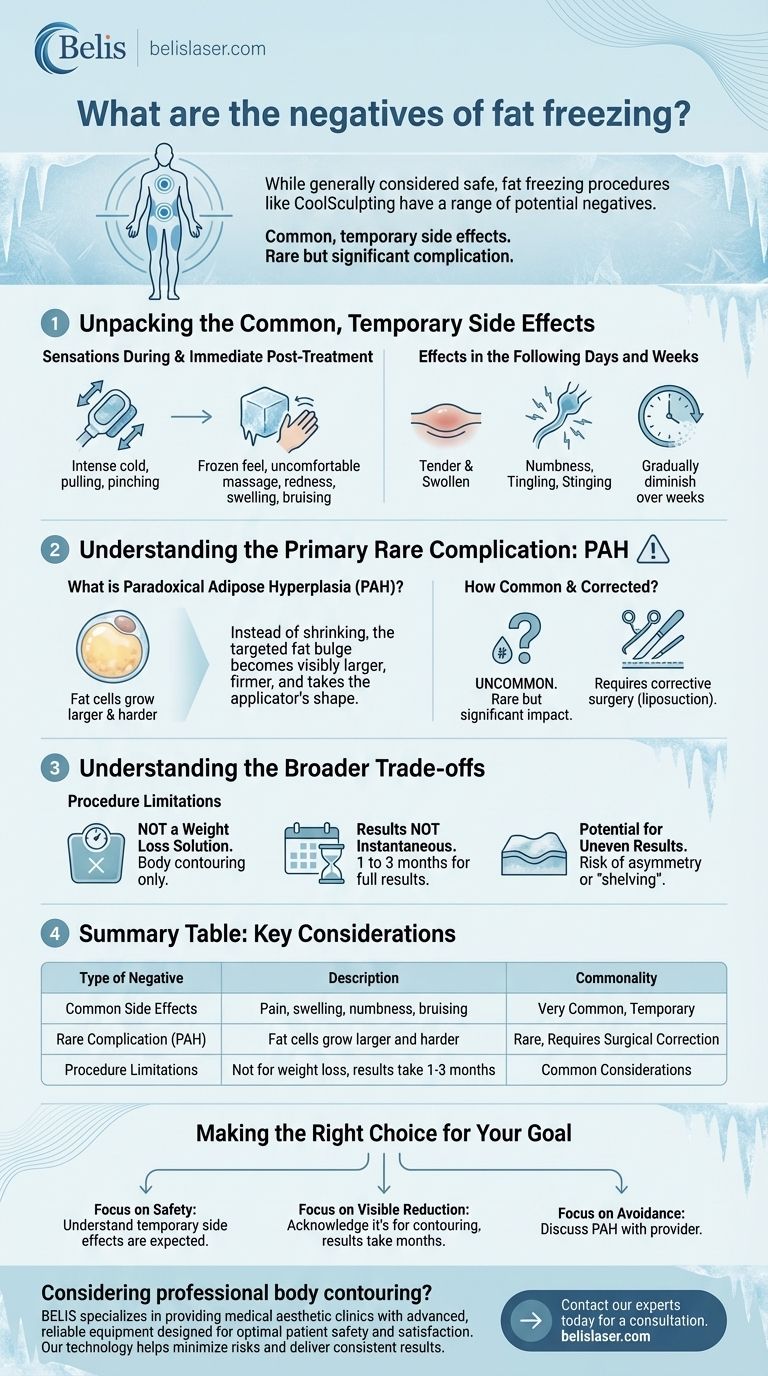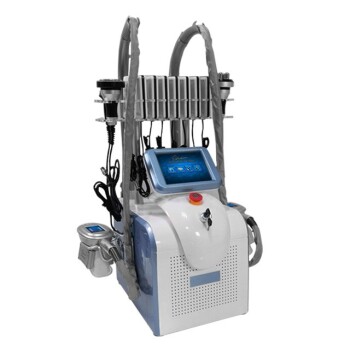While generally considered safe, fat freezing procedures like CoolSculpting have a range of potential negatives. These include common, temporary side effects such as post-procedure pain, swelling, and numbness, as well as a rare but significant complication where the targeted fat cells grow larger instead of being eliminated.
The core issue is not whether fat freezing has negatives, but understanding their nature and probability. Most side effects are temporary and localized, but users must be aware of the small risk of Paradoxical Adipose Hyperplasia (PAH), a condition that requires surgical correction.

Unpacking the Common, Temporary Side Effects
The vast majority of negatives associated with cryolipolysis (fat freezing) are mild and resolve on their own. They are a predictable part of the body's inflammatory response to the treatment.
Sensations During Treatment
During the procedure itself, you can expect to feel a combination of sensations as the applicator is applied. These typically include a strong pulling or tugging sensation, pinching, and then an intense cold that subsides into numbness after 5 to 10 minutes.
Immediate Post-Treatment Effects
Once the applicator is removed, the treated area often looks and feels like a frozen, solid block of tissue. The required post-treatment massage can be uncomfortable or painful. Common effects at this stage include temporary redness, swelling, bruising, and tenderness at the treatment site.
Effects in the Following Days and Weeks
In the days following the procedure, the area may remain tender and swollen. It is also very common to experience numbness, tingling, or stinging sensations. These feelings gradually diminish over several weeks as the nerves in the area recover.
Understanding the Primary Rare Complication: PAH
Beyond the common and expected side effects, there is a rare but serious negative outcome that you must understand before proceeding.
What is Paradoxical Adipose Hyperplasia (PAH)?
Paradoxical Adipose Hyperplasia (PAH) is a rare adverse effect where the fat cells in the treated area react to the cold by growing larger and harder, rather than dying and being eliminated. Instead of shrinking, the targeted fat bulge becomes visibly larger, firmer, and often takes the shape of the treatment applicator.
How Common is PAH?
PAH is an uncommon complication. While incidence rates vary across studies, it is considered a rare event. However, its impact is significant because it produces the opposite of the intended cosmetic result.
How is PAH Corrected?
This condition does not resolve on its own. The standard treatment for PAH is corrective surgery, typically liposuction, to remove the enlarged mass of fat tissue. This introduces the risks and costs associated with a separate surgical procedure.
Understanding the Broader Trade-offs
Evaluating the "negatives" also means looking beyond medical side effects to the limitations of the procedure itself.
It Is Not a Weight Loss Solution
Fat freezing is a body contouring tool, not a weight loss method. It is designed to reduce stubborn, localized pockets of fat that resist diet and exercise. It will not result in a significant drop on the scale or address obesity.
Results Are Not Instantaneous
Unlike surgical procedures, the results of fat freezing appear gradually. It takes time for the body to break down and clear away the dead fat cells. You may begin to see changes in as little as three weeks, but the most dramatic results typically take 1 to 3 months to become fully apparent.
Potential for Uneven Results
There is a risk of uneven or asymmetrical results, skin surface irregularities, or "shelving"—a visible demarcation between the treated and untreated areas. The skill and experience of the provider are critical in minimizing this risk.
Making the Right Choice for Your Goal
To decide if fat freezing is appropriate, you must weigh these potential negatives against your personal goals and risk tolerance.
- If your primary focus is safety: Understand that while major complications are rare, temporary side effects like numbness, swelling, and tenderness are an expected part of the process.
- If your primary focus is visible fat reduction: Acknowledge that this is a tool for modest contouring, not significant weight loss, and that results take several months to appear.
- If your primary concern is avoiding rare but serious risks: Have a direct conversation with your provider about Paradoxical Adipose Hyperplasia (PAH) to understand your personal risk profile and the clinic's protocol if it were to occur.
Ultimately, a successful outcome depends on being the right candidate and having a clear understanding of what the procedure can and cannot do.
Summary Table:
| Type of Negative | Description | Commonality |
|---|---|---|
| Common Side Effects | Pain, swelling, numbness, bruising | Very Common, Temporary |
| Rare Complication (PAH) | Fat cells grow larger and harder instead of being eliminated | Rare, Requires Surgical Correction |
| Procedure Limitations | Not for weight loss, results take 1-3 months, risk of uneven contouring | Common Considerations |
Considering professional body contouring?
BELIS specializes in providing medical aesthetic clinics and premium beauty salons with advanced, reliable equipment designed for optimal patient safety and satisfaction. Our technology helps minimize risks and deliver consistent, high-quality results.
Let us help you enhance your practice with superior technology. Contact our experts today for a consultation.
Visual Guide

Related Products
- Fat Freezing Cryolipolysis Machine for Body Contouring
- Fat Freezing Cryolipolysis Machine for Body Contouring
- Cryolipolysis Fat Freezing Machine and Ultrasonic Cavitation Device
- Cryolipolysis Fat Freezing Machine Ultrasonic Cavitation Fat Reducing Device
- Cryolipolysis Fat Freezing Machine with Cavitation and Laser Lipolysis
People Also Ask
- How does fat leave the body after fat freezing? The Science of Permanent Fat Cell Removal
- How long do fat freezing results last? Permanently Remove Stubborn Fat Cells
- Are there any risks with fat freezing? A guide to understanding cryolipolysis side effects
- Does fat freezing work on belly fat? Effectively Sculpt Your Abdomen
- Do fat freezing machines work? A Realistic Guide to Body Contouring Results



















